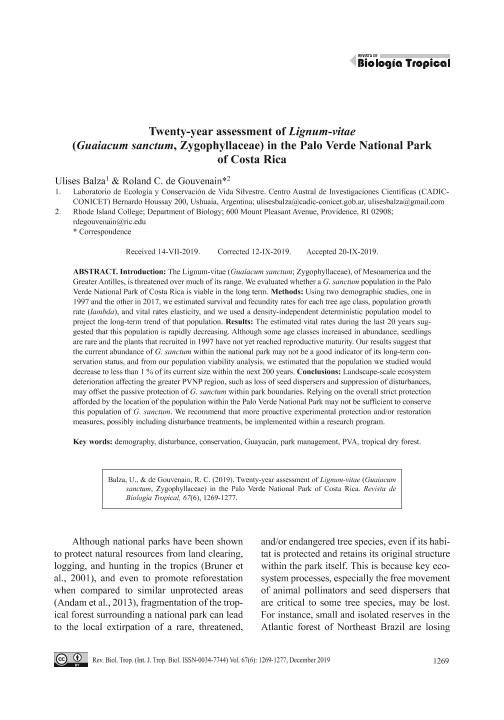Mostrar el registro sencillo del ítem
dc.contributor.author
Balza, Ulises

dc.contributor.author
De Gouvenain, Roland Charles
dc.date.available
2020-12-01T15:30:31Z
dc.date.issued
2019-12
dc.identifier.citation
Balza, Ulises; De Gouvenain, Roland Charles; Twenty-year assessment of Lignum-vitae (Guaiacum sanctum, Zygophyllaceae) in the Palo Verde National Park of Costa Rica; Revista de Biología Tropical; Revista de Biología Tropical; 67; 6; 12-2019; 1269-1277
dc.identifier.issn
0034-7744
dc.identifier.uri
http://hdl.handle.net/11336/119469
dc.description.abstract
Introduction: The Lignum-vitae (Guaiacum sanctum; Zygophyllaceae), of Mesoamerica and the Greater Antilles, is threatened over much of its range. We evaluated whether a G. sanctum population in the Palo Verde National Park of Costa Rica is viable in the long term. Methods: Using two demographic studies, one in 1997 and the other in 2017, we estimated survival and fecundity rates for each tree age class, population growth rate (lambda), and vital rates elasticity, and we used a density-independent deterministic population model to project the long-term trend of that population. Results: The estimated vital rates during the last 20 years suggested that this population is rapidly decreasing. Although some age classes increased in abundance, seedlings are rare and the plants that recruited in 1997 have not yet reached reproductive maturity. Our results suggest that the current abundance of G. sanctum within the national park may not be a good indicator of its long-term conservation status, and from our population viability analysis, we estimated that the population we studied would decrease to less than 1 % of its current size within the next 200 years. Conclusions: Landscape-scale ecosystem deterioration affecting the greater PVNP region, such as loss of seed dispersers and suppression of disturbances, may offset the passive protection of G. sanctum within park boundaries. Relying on the overall strict protection afforded by the location of the population within the Palo Verde National Park may not be sufficient to conserve this population of G. sanctum. We recommend that more proactive experimental protection and/or restoration measures, possibly including disturbance treatments, be implemented within a research program.
dc.format
application/pdf
dc.language.iso
eng
dc.publisher
Revista de Biología Tropical

dc.rights
info:eu-repo/semantics/openAccess
dc.rights.uri
https://creativecommons.org/licenses/by/2.5/ar/
dc.subject
CONSERVATION
dc.subject
DEMOGRAPHY
dc.subject
DISTURBANCE
dc.subject
GUAYACÁN
dc.subject
PARK MANAGEMENT
dc.subject
PVA
dc.subject
TROPICAL DRY FOREST
dc.subject.classification
Ciencias de las Plantas, Botánica

dc.subject.classification
Ciencias Biológicas

dc.subject.classification
CIENCIAS NATURALES Y EXACTAS

dc.subject.classification
Conservación de la Biodiversidad

dc.subject.classification
Ciencias Biológicas

dc.subject.classification
CIENCIAS NATURALES Y EXACTAS

dc.subject.classification
Ecología

dc.subject.classification
Ciencias Biológicas

dc.subject.classification
CIENCIAS NATURALES Y EXACTAS

dc.title
Twenty-year assessment of Lignum-vitae (Guaiacum sanctum, Zygophyllaceae) in the Palo Verde National Park of Costa Rica
dc.type
info:eu-repo/semantics/article
dc.type
info:ar-repo/semantics/artículo
dc.type
info:eu-repo/semantics/publishedVersion
dc.date.updated
2020-11-26T17:47:56Z
dc.journal.volume
67
dc.journal.number
6
dc.journal.pagination
1269-1277
dc.journal.pais
Costa Rica

dc.journal.ciudad
Turrialba
dc.description.fil
Fil: Balza, Ulises. Consejo Nacional de Investigaciones Científicas y Técnicas. Centro Austral de Investigaciones Científicas; Argentina
dc.description.fil
Fil: De Gouvenain, Roland Charles. Rhode Island College; Estados Unidos
dc.journal.title
Revista de Biología Tropical

dc.relation.alternativeid
info:eu-repo/semantics/altIdentifier/url/https://revistas.ucr.ac.cr/index.php/rbt/article/view/38338
dc.relation.alternativeid
info:eu-repo/semantics/altIdentifier/doi/http://dx.doi.org/10.15517/RBT.V67I6.38338
Archivos asociados
